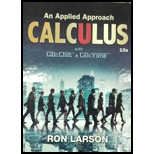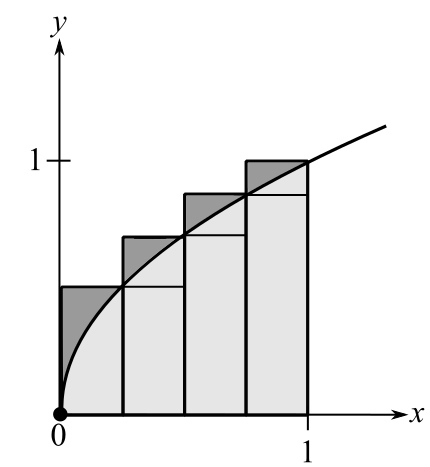
Calculus: An Applied Approach (MindTap Course List)
10th Edition
ISBN: 9781305860919
Author: Ron Larson
Publisher: Cengage Learning
expand_more
expand_more
format_list_bulleted
Concept explainers
Question
Chapter B, Problem 3E
To determine
To calculate: The approximate area of the region lying between the graph of

Expert Solution & Answer
Want to see the full answer?
Check out a sample textbook solution
Students have asked these similar questions
For the solid lying under the surface z = √√4-² and bounded by the rectangular region
R = [0,2]x[0,2] as illustrated
in this graph:
Double Integral
Plot of integrand over Region R
1.5
Z
1-
0.5-
0 0.5
1
1.5
205115
Answer should be in exact math format. For example, some multiple of .
Find
2
S²
0
0
(4x+2y)5dxdy
(14 points) Let S = {(x, y, z) | z = e−(x²+y²), x² + y² ≤ 1}. The surface is the graph of
ze(+2) sitting over the unit disk.
Chapter B Solutions
Calculus: An Applied Approach (MindTap Course List)
Ch. B - Using Rectangles to Approximate the Area of a...Ch. B - Prob. 2ECh. B - Prob. 3ECh. B - Prob. 4ECh. B - Prob. 5ECh. B - Prob. 6ECh. B - Prob. 7ECh. B - Prob. 8ECh. B - Comparing Riemann Sums Consider a triangle of area...Ch. B - Comparing Riemann Sums Consider a trapezoid of...
Ch. B - Writing a Definite Integral In Exercises 1118, set...Ch. B - Writing a Definite Integral In Exercises 11-18,...Ch. B - Writing a Definite Integral In Exercises 1118, set...Ch. B - Prob. 14ECh. B - Writing a Definite Integral In Exercises 1118, set...Ch. B - Prob. 16ECh. B - Prob. 17ECh. B - Writing a Definite Integral In Exercises 11-18,...Ch. B - Prob. 19ECh. B - Prob. 20ECh. B - Prob. 21ECh. B - Prob. 22ECh. B - Prob. 23ECh. B - Prob. 24ECh. B - Prob. 25ECh. B - Prob. 26ECh. B - Prob. 27ECh. B - Finding Areas of Common Geometric Figures In...Ch. B - Prob. 29ECh. B - Prob. 30ECh. B - Prob. 31ECh. B - Prob. 32E
Knowledge Booster
Learn more about
Need a deep-dive on the concept behind this application? Look no further. Learn more about this topic, calculus and related others by exploring similar questions and additional content below.Similar questions
- 6. Solve the system of differential equations using Laplace Transforms: x(t) = 3x₁ (t) + 4x2(t) x(t) = -4x₁(t) + 3x2(t) x₁(0) = 1,x2(0) = 0arrow_forward3. Determine the Laplace Transform for the following functions. Show all of your work: 1-t, 0 ≤t<3 a. e(t) = t2, 3≤t<5 4, t≥ 5 b. f(t) = f(tt)e-3(-) cos 4τ drarrow_forward4. Find the inverse Laplace Transform Show all of your work: a. F(s) = = 2s-3 (s²-10s+61)(5-3) se-2s b. G(s) = (s+2)²arrow_forward
- 1. Consider the differential equation, show all of your work: dy =(y2)(y+1) dx a. Determine the equilibrium solutions for the differential equation. b. Where is the differential equation increasing or decreasing? c. Where are the changes in concavity? d. Suppose that y(0)=0, what is the value of y as t goes to infinity?arrow_forward2. Suppose a LC circuit has the following differential equation: q'+4q=6etcos 4t, q(0) = 1 a. Find the function for q(t), use any method that we have studied in the course. b. What is the transient and the steady-state of the circuit?arrow_forward5. Use variation of parameters to find the general solution to the differential equation: y" - 6y' + 9y=e3x Inxarrow_forward
- Let the region R be the area enclosed by the function f(x) = ln (x) + 2 and g(x) = x. Write an integral in terms of x and also an integral in terms of y that would represent the area of the region R. If necessary, round limit values to the nearest thousandth. 5 4 3 2 1 y x 1 2 3 4arrow_forward(28 points) Define T: [0,1] × [−,0] → R3 by T(y, 0) = (cos 0, y, sin 0). Let S be the half-cylinder surface traced out by T. (a) (4 points) Calculate the normal field for S determined by T.arrow_forward(14 points) Let S = {(x, y, z) | z = e−(x²+y²), x² + y² ≤ 1}. The surface is the graph of ze(+2) sitting over the unit disk. = (a) (4 points) What is the boundary OS? Explain briefly. (b) (4 points) Let F(x, y, z) = (e³+2 - 2y, xe³±² + y, e²+y). Calculate the curl V × F.arrow_forward
- (6 points) Let S be the surface z = 1 − x² - y², x² + y² ≤1. The boundary OS of S is the unit circle x² + y² = 1. Let F(x, y, z) = (x², y², z²). Use the Stokes' Theorem to calculate the line integral Hint: First calculate V x F. Jos F F.ds.arrow_forward(28 points) Define T: [0,1] × [−,0] → R3 by T(y, 0) = (cos 0, y, sin 0). Let S be the half-cylinder surface traced out by T. (a) (4 points) Calculate the normal field for S determined by T.arrow_forwardI need the last answer t=? I did got the answer for the first two this is just homework.arrow_forward
arrow_back_ios
SEE MORE QUESTIONS
arrow_forward_ios
Recommended textbooks for you
- Algebra & Trigonometry with Analytic GeometryAlgebraISBN:9781133382119Author:SwokowskiPublisher:Cengage

Algebra & Trigonometry with Analytic Geometry
Algebra
ISBN:9781133382119
Author:Swokowski
Publisher:Cengage
Numerical Integration Introduction l Trapezoidal Rule Simpson's 1/3 Rule l Simpson's 3/8 l GATE 2021; Author: GATE Lectures by Dishank;https://www.youtube.com/watch?v=zadUB3NwFtQ;License: Standard YouTube License, CC-BY